MAJOR SIGHTS IN TOKYO
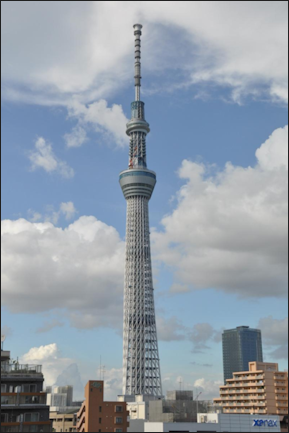
Tokyo Sky Tree Toranomon Hills (in the Toranomon district of Minato, subway Hibiya Line, Toranomon Hills Station) is the tallest building in Tokyo at 255.5 meters (838 feet) in height. Midtown Tower which (248 meters tall) is the second highest building in Tokyo. Opened in 2014 and built around the new Loop Road No. 2, Toranomon Hills was constructed by Mori Building and designed by Nihon Sekkei and has 52 floors. Address: 23-1~4 Toranomon 1 chome, Minato-ku, Tokyo
According to Tokyo Weekender: The development has been billed as a new flagship for urban living, and features state-of-the-art anti-earthquake and disaster measures and a green space at the base of the building. Toranomon Hills features 24 shops and restaurants on its first three floors, 30 floors of offices, 10 floors of residences, and the Andaz Hotel by Hyatt with 164 rooms on floors 47–52. To free up space on the ground level, the building contains a 14-kilometer underground loop-road for street access and parking, amounting to a highly efficient five-floor space below ground. Mori Building Co also built Roppongi Hills, Omotesando Hills, and Ark Hills.[Source: Tokyo Weekender, June 5th, 2014]
Sunshine 60 Building (in Ikebukuro) is one of the tallest buildings in Asia. It is 60 stories high and also boasts the world's former fastest elevator which ascends 60 floors in 35 seconds. Here you find Sunshine City, a shopping and entertainment complex with an observatory 240 meters (787 feet) off the ground, along with Namco Namja Town (an indoor theme park), the Sunshine International Aquarium, the Konica Minolta planetarium and the Ancient Orient Museum. Website: Wikipedia Wikipedia
Ueno Zoological Gardens (in Ueno Park) features elephants that have trouble mating and a new $15 million vivarium with 130 kinds of fish, reptiles and amphibians. Ueno Zoo attracts 3.5 million visitors a year. Many of them have come over the years to see the panda Ling Ling who died at the age of 22 in May 2008. The zoo has had pandas since 1972 when a pair of pandas was given to Japan and the zoo by China. After Ling Ling’s death China said it would loan the zoo a pair of pandas. Ueno Zoo was finally given a pair of pandas — a male named Ri Ri (“Power”) and a female named Shin Shin (“Truth”) — in 2011. They were supposed to go on display in March that year but their unveiling was delayed until April because of the earthquake and tsunami
See Separate Article TOKYO SKYTREE AND TOKYO TOWER: THEIR FEATURES, CONSTRUCTION AND VISITING THEM factsanddetails.com
National Diet Building
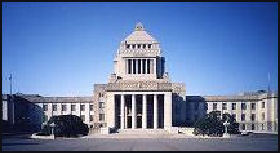
National Diet Building (Kokkai Gijido-mae subway station) is the home of the Japanese government. It is an imposing, white, three-story structure with a massive 200-foot-high, pyramid-topped tower. The right half of the building contains the House of Councilors (252 seats) and the left side contains the House of Representatives (480 seats).
The Diet building was erected in 1936. The mausoleum-like tower was reportedly inspired by Tomb of Halicarnassus, one of the Seven Wonders of the World. The building was built in part to honor Hirobumi Ito, "father" of the prewar constitution.
Tours of the Diet Building are popular, with almost a million visitors participating in them each year. According to the Yomiuri Shimbun: “One reason for this popularity may be that the tours are free. Applications to visit the House of Representatives or the House of Councillors are separately accepted by the secretariat of each house. The standard one-hour tour of the building includes a visit to the assembly hall of each chamber and a rest area for the Emperor. Tours of the Diet Building are sometimes included in school study tours and sightseeing tours in central Tokyo.” [Source: Yomiuri Shimbun, August 25, 2014]
Admission tickets are available to the Visitors Gallery. Most of the time there is little action: sleepy debates and speeches but occasionally there are aggressive pushing and shoving matches around the microphone. The Kasaumigaeski District, where the National Diet Building is located, is the political and administrative center of Japan. Websites: Wikipedia Wikipedia ; Japan Visitor Japan Visitor
Tokyo Temples and Shrines
Zojoji Temple (near Tokyo Tower in Shiba Park) was built by the Tokugawa Shoguns to house the rare black Buddha. Nearly all the 48 temples that once occupied the site were destroyed by fires or development. Sanmon, the gate built in the 1700s, is said to one of the oldest standing wooden structures in Japan. Most structures were built after World War II. There are many cherry trees here. A procession dedicated to temple’s founder often coincides with cherry blossum season.
Yushima is one of Tokyo's oldest shrines. Founded in the mid-14th century, before Edo (Tokyo) itself was founded, it is dedicated to Michizane Sugawara, an acclaimed poet-scholar of the Heian Period (894-1185) who was falsely accused of treason and exiled before he died in 903. The shrine was commissioned by the Emperor as an act of atonement after he realized he made a mistake. The grounds are beautifully landscaped with gnarled plum trees. Website:Shrine homepage yushimatenjin
Gotokuji Temple (Gotokuji Station, Odakyu Line, Setagaya Ward) contains a shrine dedicated to the worship of beckoning cats. Situated in a quiet residential district, it was founded in 1480 and became associated with beckoning cats after a 17th century feudal lord avoided being caught in a torrential downpour by finding refuge in a temple after being beckoned there by a cat. Many people pray for good fortune and good business in the shrine. Many beckoning cats are displayed around the shrine.
Ushiku Great Buddha in listed in the Guinness Book of World Records as the tallest Buddha statue in the world. Completed in 1993, and jointly produced by Japan and Taiwan, it is 394 feet tall, 115 feet wide and weighs 1,100 tons. Visitors can take an elevator up to the statue’s chest. Websites: Wikipedia Wikipedia
Sengakuji Temple (near Senakuji subway station) is a modest temple dedicated to the 47 samurai who committed ritual suicide in 1702 to protest the unfair treatment of a feudal lord. Everyone in Japan knows the story. The 47 samurai are buried next to their lord. Their armor and possessions, including white-trimmed black ninja suits, are on display in a small museum (See History, Samurai, for the 47 Samurai story). Around the temple are samurai graveyards and other temples and shrines. Nearby, in the side streets off of Sakurada-dori, are traditional wooden houses that survived the firebombing during World War II. Website: Japan Guide japan-guide.com
Asakusa Kannon Temple
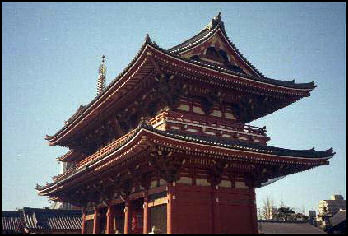
Asakusa Kannon Temple (in the middle of Asakusa Park) contains a large five-story Buddhist pagoda and is home to the “Thunder Gate,” with its massive red lantern, one of the most popular photo spots in Tokyo. Also known as Sensoji, the temple enshrines a gold Buddha statue said to have been miraculously netted by a fisherman in A.D. 628. Millions of pilgrims have come from all over Japan over the centuries to see it. During the 1923 earthquake, when Tokyo was engulfed in flames, thousands sought refuse in temple and were saved by its open spaces.
Asakusa Kannon Temple is Tokyo's best known temple. The huge red lantern that hand from Kaminarimon (“Thunder”) Gate weighs more than ton. The pagoda is situated in a beautiful Japanese garden. The temple is also the site of the Sanja Festival in May, a Plant Fair in May, June and July, the Ground Cherry Fair in July and the Battledore Fair in mid-December.
Large weekend crowds visit the temple to make offerings and light incense in the temple buildings and go shopping and play video games at the shops and amusement centers located within the temple grounds. The lively open air market on Nakasmise Dori is a good place to shop for souvenirs. It is filled with stalls selling dolls, kimonos, wigs, crackers, lacquerware, ceramics, paper fans, tourist kitsch, and other stuff. South of the temple a Edo period neighborhood has been recreated on Denboin-dori street. Website: Japan Guide japan-guide.com
Meiji Shrine
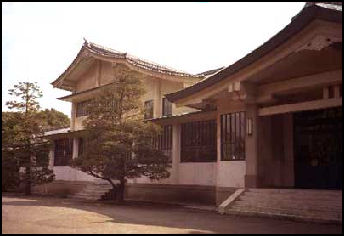
Meiji Shrine (in Yoyogi Park) is a popular and impressive shrine, dedicated Emperor Meiji, the 19th century ruler who became a symbol for the modernization of Japan. Set in a forested area of Yoyogi Park, it embraces the lovely Inner Garden, famous for its river of irises that bloom in May and a torii gate said to be one of the largest in Japan. It is a serene place surprising close to some of Tokyo most heavily urbanized areas.
Connected to the Inner Garden by a broad cherry-tree lined avenue is the Outer Garden, which contains the Memorial Picture Gallery, various sports facilities including the Yoyogi Sports Center, Komazawa Sports center, the ultra-modern National Indoor Stadium and its shell-shaped annex constructed for 1964 Olympics, and the National Stadium. Nearby is the Tobacco and Salt Museum. Website: Meiji Jingu site meijijingu.or.jp
Yasukuni Shrine
Yasukuni Shrine (near the Imperial Palace) is memorial whose purpose is to honor and deify hundreds of thousands who died in World War II and other conflicts in the late 19th and early 20th century. In some ways it the Japanese equivalent of Arlington National Cemetery except no one is buried there.
Founded in 1869 as a way of healing wounds of the Boshin Civil War and located on a hill overlooking the Emperor's Palace, Yasukuni Shrine is a simple Shinto-style building located the end of a 500-yard promenade in a 24 acre park. It is a weathered wooden shrine, like many in Japan, except for the strong presence of purple curtains bearing the chrysanthemum crest of the Emperor, flocks of specially-bred white doves that visitors can feed, a museum with controversial items and a Book of the Dead with some controversial names.
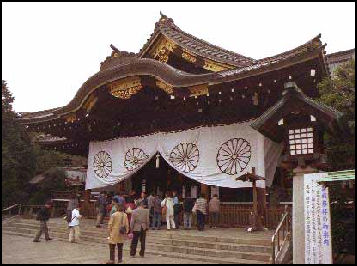
Yasukuni means “Peaceful Nation.” A book at the shrine lists 2.46 million war dead regarded as gods, including soldiers who died in the “Greater East Asian War” (World War II), participants Rape of Nanking, high school students who died defending Okinawa, nurses and engineers who died on the battlefield, and soldiers who were killed in the Russo-Japanese war but does not include civilians who died in Hiroshima, Nagasaki or the fire bombing raids.
Yasukuni not only honors soldiers but anyone who died in service to the Emperor, and includes men, women and children. Since Japan has not fought any wars since World War II only a handful of people have been enshrined since then, namely soldiers killed in car accidents while on duty and none of these has been enshrined with the complete Shinto ceremony. If a Japanese soldier had been killed in Iraq he would have been enshrined.
The dead at Yasukuni were enshrined with a Shinto ceremony in which their names were written down on a scroll and then ceremoniously placed on a palanquin and carried into the shrine, essentially recognizing them as kami (“gods” or “spirits”). During the peak of fighting in World War II sometimes 30,000 people were enshrined in a single day.
Controversy Over Yasukuni Shrine
The shrine is not popular with Chinese and Koreans who say it glorifies participants in war crimes in their countries. Some Americans say it glories World War II war criminals. According to the BBC and Washington Post: “Yasukuni Shrine was built in 1869 under the Emperor Meiji. It memorializes almost 2.5 million Japanese, including women and children, who died in wars since 1868. The overwhelming majority — about 2.1 million — died in World War II. What makes the shrine so controversial is the fact that it honors hundreds of convicted war criminals, including 14 so-called Class A criminals, such as executed war-time leader Hideki Tojo, the prime minister who authorized the 1941 attack on Pearl Harbor. Their spirits have been "enshrined" there since 1960s and 70s. Shrine organizers stress that many thousands of civilians are honored. China and South Korea however see the shrine as glorification of Japanese atrocities. The 14 "Class A" war criminals were the men who ordered and oversaw Japan’s brutal war in China and South East Asia, which left millions dead and included widespread massacres of civilians, rape used routinely as a weapon and the use chemical and biological weapons by the Japanese against civilians.”
Yasukuni became a center of controversy in the early 2000s when it was repeatedly visited by Japanese Prime Minister Juichiro Koizumi, a move that angered many, particularly Chinese and Koreans that suffered under Japanese rule before and during World War II. What makes the shrine so anger-provoking is the fact that it specifically honors 14 Class A war criminals, including Tojo and six others that were executed for their action in World War II after the war was over. On the shrine website it refers to all 1,068 those tried as war criminals during the 1946-48 Tokyo Trial as “Martyrs of Showa” who “were cruelly and unjustly tried as war criminals by a sham-like tribunal of the Allied forces. These martyrs are the kami of Yasukuni jinja.”
Yasukuni is a Mecca for Japanese right-wing extremists and nationalists, some of whom stand outside the shrine and give out leaflets exclaiming "Japan was not an aggressor!" and the “Showa martyrs...were cruelly executed because they were falsely accused as war criminals in a one-sided tribunal? Vans with loudspeakers that scream out similar messages.” Websites: Yasukuni site yasukuni.or.jp ; Wikipedia Wikipedia ;Japan Guide japan-guide.com
Yushukan Museum
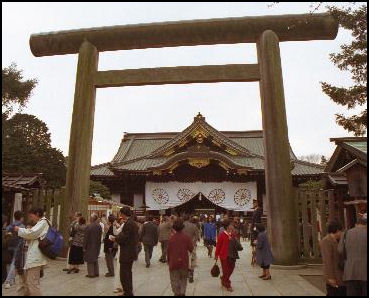
Yushukan Museum (part of Yasukuni Shrine) is the military museum in a large Western-style building on one side of Yasukuni shrine. Sometimes called the Hall for Commuting with Noble Souls, it contains warship models, a shot up tank, a diorama showing human-powered, rocket-guided bombs, blood-stained uniforms, bullet-ridden helmets, swords, guns, a beautifully restored Zero fighter, a Sakura suicide jet, other weapons and a "panorama of the Divine Thunderbolt Corps in final attack mode at Okinawa."
Upstairs is simple room, with piped in somber music, filled with photographs of kamikaze pilots and letters they wrote. You can also see a miracle coconut set afloat by a Japanese soldier in the Philippines that was found 30 years later on a beach near his widow's home.
Outside the museum is Steam Locomotive C5631, the first locomotive to travel on the infamous POW-built Burma Railroad, and a statue of a man with aviator headgear dedicated to "The Brave Men Who Made the Special Attacks"— kamikaze pilots — who died in World War II. Most of the captions are in Japanese.
What makes the museum particularly instigative is the fact that it portrays Japan as the great liberator of Asia in the 1930s; celebrates the brutal campaign in China; and argue that Emperor Hirohito wanted peace until the end and it was Roosevelt’s stubbornness that kept the war going. The museum describes the attack on Pearl Harbor as an act of “self-defense” and says that Japanese expansion was an effort to free Southeast Asia from European and American colonial rule and bring benevolent rule to Korea and China.
Exhibits at the museum state the “incident” in Nanking allowed residents there to “once again live their lives in peace” and says that Roosevelt lured Japan into World War II and the attack of Pearl Harbor was part of his secret “Plan Victory” to bring an end to the Great Depression by “using embargoes to force resource-poor Japan into war.” Japan is generally portrayed as a victim of war that was forced to defend itself by any means possible, including attacks by kamikaze pilots and human-guided torpedoes. It is disturbing to see large groups of schoolchildren in the museum being subjected this propaganda.
In 2006, the shrine “softened” it references to China and referred to Chinese as well as Japanese texts so the museum could not be accused of being one-sided. The museum also said it would alter it displays stating that the United States deliberately forced Japan into the war but refused to go as far as calling Japan’s actions a “war of aggression.” In a 24-acre park near the shrine is a bronze statue of Masujiro Omura, the 19th century founder of Japan's modern army.
Architectural Sights in Tokyo
Jiyu Gakuen Myonichikan was built in 1921 as the main building of a private allgirls’ school established by publishers Motoko and Yoshikazu Hani. Designed by American architect Frank Lloyd Wright, his prairie-style architecture is implemented here to create a warm, domestic learning environment with basic materials of wood and plaster, large windows, and low, approachable structure. Location: 2-31-3 Nishiikebukuro, Toshima-ku, Tokyo 171-0021 +81-3-3971-7535.
Split Machiya (Shinjuku) is only three meters wide. Yoshiharu Tsukamoto and Momoyo Kaijima represented Japan at the 2010 Venice Biennale under the name Atelier Bow-Wow. Their architecture is often compared to M.C. Escher’s drawings, where everything starts and nothing ends – always in the service of space illusion. In Shinjuku the couple built a family residence that’s only three meters wide, called Split Machiya (split townhouse) . “For every design detail, we took the building’s three-meter-width into consideration,” explains Tsukamoto. “The furniture is slightly lower and the restroom under the stairway.
Copper partially covers walls to reflect the garden outside.” Multifunctionality is an effective architectural tool, as also demonstrated in the entrance area, where the wardrobe serves as a piano room. As for their source of inspiration, Tsukamoto and Kaijima refer to a meditation room on top of their studio building not far from Split Machiya, a room just big enough for a person to sit down and absorb the neverending horizon of Tokyo and its endless possibilities of limited space.-rh I concluded that spaciousness is not so much a matter of how far you put walls apart. More important is to provoke new and unfamiliar feelings.
Interesting Modern Building in Tokyo
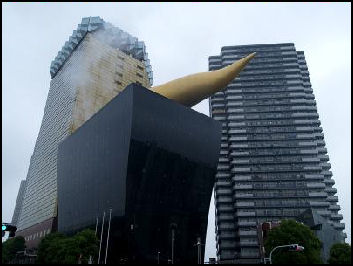
Asahi building Tange Kenzo is one of Japan's most acclaimed architects. His works in Tokyo include the Tokyo Metropolitan Government Offices in Shinjuku and the United Nations University near Omotesando subway station. Some people claim the most extraordinary structure of all is the Tokyo Metropolitan Expressway, a 220-kilometer system of highways and interchanges that is largely elevated above the city and has been compared with the Roman aqueducts and the Great Inca Road. See Designer Shopping in Ginza, West Side of Shinjuku Station, National Art Center Tokyo and Roppongi Museums, Roppongi Hills and Tokyo Midtown Above
Other modern is buildings of interest include the NC building (Shin-Koiwa Station on the JR Sobu Line) designed by Peter Eisenman; the Tokyo International Forum (next to Yuraku-cho Station); the Edo-Tokyo Museum in Ryoguku; the Spiral building in Aoyama; the Bunkamura, the Humax Building and Shibuya Beam in Shibuya; and the Odaiba complex on Tokyo Bay.
Asahi Beer Headquarters (downtown Asakusa) is famous for the granite structure on its roof. The sculpture is supposed to represent beer foam. Many Tokyoites say it reminds them of a piece of shit. Designed by Phillipe Stack, the building also boasts an extraordinary exterior and interior.
Pineapple Sunnyhills (Omotesando in Minami-Aoyama) from the outside it looks like a giant nest made of randomly piled up wooden planks, and absent any signage or even a hint of what's inside. Positioned along a side street leading to the Prada flagship store on Omotesando, one might assume that it has something to do with fashion, but of all things it's a sweets shop owned by Taiwanese pineapple cake maker SunnyHills. Architect Kengo Kuma playfully recreated the rough surface of a pineapple, and inside the stylish environment visitors can enjoy pineapple cake and tea while they take in the atmosphere. Location: 3-10-20 Minami-Aoyama, Minato-ku, Tokyo 107-0062 , Tel:+81-3-3408-7778.
Gardens in Tokyo
Tokyo is not especially known for its gardens. Tokyo's most beautiful gardens include Hama Rikyu, and Koishikawa garden as well as Koishikawa Botanical Gardens and Shinjuku National Garden. One and half miles from the Imperial palace is Korakuen Gardens, one of the few great classical gardens in Tokyo. North of Tokyo in Mito is Kairakuen Gardens, one of Japan's three most beautiful gardens. Rikugien Garden (near Komagome Station on the Yamanote line) is a classic Japanese garden established in 1702.
Cherry Blossoms: Good places to see cherry blossoms in the Tokyo area include Ueno Park, Sumida Park (Asakura Station), Yakushina Shrine, Chidorigafuchi by the moat at the Imperial Palace, Showa Memorial Park (Nishi-Tachikawa Station), Aoyama Cemetery (Nogizaka Station) and Shinjuki Gyeon.
Kiyosumi Garden (Kiyosumi Shiakawa Station on the Oedo subway line) was originally the estate of a wealthy 18th century merchant. Restored by the founder of the Mitsubishi conglomerate, the gardens features numerous bonsai and a tea house that juts out into a lake. Kiyosumi Garden is a strolling garden laid out in the 19th century. It is celebrated for the rocks collected from all parts of Japan. Address: 3-3-9 Kiyosumi, Koto-ku, Tokyo Hours Open: 9:00am-5:00pm Admission: ¥150 Getting There: The garden is a three minute walk from Exit A3 at Kiyosumi Shiakawa Station on the Oedo subway line. Websites: Japan Guide japan-guide.com
Koishikawa Korakuen Garden (near Iidabashi Subway Station) is a strolling garden constructed in the 17th century with four special features: 1) The basic structure is traditional. 2) Its subtheme is the duplication of famous sites around Japan. 3) It incorporates Chinese gardening styles 4) It was the first to create a Tsukiyama in the shape of Mt. Fuji. Address: 1-6-6 Koraku, Bunkyo-ku, Tokyo Hours Open: 9:00am-5:00pm Admission: ¥300. Getting There: 3-minute walk from Iidabashi Subway Station.
Rikugien Garden (Komagome Station) is a strolling garden constructed in the 18th century in the Edo period under the supervision of Yanagisawa Yoshiyasu, a former “kosho” (page) promoted to the highest rank ever as feudal lord. Fond of waka poetry and Confucian teachings, Yanagisawa Yoshiyasu selected 88 scenes from his favorite poems and incorporated them in his gardening. The main motifs are the town’s prosperity in the Dokutsu-iwa (Cave Rock) and the prosperity of Imoseyama Hill. The premises include a large pond with an island and a hill covered with a dense grove of trees. Address: 6-16-3 Honkomagome, Bunkyo-ku, Tokyo Hours Open: 9:00am-5:00pm Admission: ¥300. Getting There: seven-minute walk from Komagome Station.
Kyu-Shiba-Rikyu Garden (Hamamatsucho Station) is a strolling garden constructed in the 17th century. One can command a bird’s-eye view of the whole garden from the observatory of the Sekai Boeki Center Building nearby. Address: 1-4-1 Kaigan, Minato-ku, Tokyo Hours Open: 9:00am-5:00pm Admission: ¥150. Getting There: Next to Hamamatsucho Station. Higashi Gyoen Garden (Hamamatsucho Station) is part of the Imperial Palace open to the public. Different flowers can be enjoyed each season. Address: 1-1 Chiyoda, Chiyoda-ku, Tokyo Hours Open: 9:00am-5:00pm (–16:30 March–April 14, September–October, –16:00 November–February) Closed: Monday, Friday, and days with special Imperial occasions Admission: Free. Getting There: Next to Hamamatsucho Station. Close to Takebashi Station on Subway Tozai Line or Otemachi Station.
Shinjuku Gyoen National Garden (Shinjuku Gyoenmae Station on Subway Marunouchi Line) is one of Tokyo’s largest and most popular parks for strolling and admiring the flowering shrubs and foliage. It is particularly splendid during the cherry blossom season. This garden covers a large area of 58.3 hectares and offers rich greenery and tranquility, completely secluded from the hustle and bustle of Metropolitan Tokyo. It is known an excellent place to see flowers and wild birds. Address: 11 Naito-cho, Shinjuku-ku, Tokyo. Hours Open: 9:00am-4:00pm Closed: Monday and December29-January3 (If a Monday is a public holiday, then closed the following day Admission: ¥200. Getting There: 5-minute walk from Shinjuku Gyoenmae Station on Subway Marunouchi Line.
Hama-Rikyu Garden (Shiodome Station or Tsukiji-ichiba Station on Subway Oedo Line) is a strolling garden constructed in the 17th century. It is unique among Tokyo gardens in having a tidal pond that empties into Tokyo Bay.
Hama-rikyu Gardens The garden is a metropolitan garden of Tokyo located at the mouth of the Sumida River in Chuo-ku. It is called Hama-rikyu for short and cherished by all citizens. It is a landscape garden in a circular style with a tidal pond called Shioiri-no-ike. It was remodeled as a metropolitan garden on the site of the villa of the Tokugawa Shogun’s family built in the 17th century. The garden has an atmosphere of utter tranquility where visitors can forget the passage of time. Visitors can also enjoy matcha (powdered green tea) and Japanese confections as refreshments at Nakajima-no-ochaya, a teahouse built on Nakajima Islet located in the middle of the pond.
Address: Hamarikyu-Teien, Chuo-ku, Tokyo Hours Open: 9:00am-5:00pm (enter by 4:30pm) Closed: December29-January1 Admission: ¥300. Getting There: 7-minute walk from Shiodome Station or Tsukiji-ichiba Station on Subway Oedo Line.
Gardens Near Tokyo
Yoshini Baigo (an hour from Tokyo) is a village on the banks of the Tama River with over 25,000 plum trees. The four-kilometers-long area with the trees stretches that runs between Hinatawada and Futamatao stations on the JR Ome line and includes the Ume-no-Koen park, which has ¥200 entrance fee. Over 300,000 people flock to the area during the month-long Ume Matsuri (Plum Festival). The blossoms are normally at their peak during early- to mid-March,
Yokohama Sankeien Garden (five-minute walk from Hommoku Sankeien-mae Bus Stop) is a strolling garden built by Hara Tomitaro (1868-1939), a business tycoon of Yokohama. It contains many historic buildings which have been brought from many parts of the country. Different flowers can be enjoyed each season; lotus, iris, plum, azalea and so on. Address: 58-1, Hommoku Sannotani, Naka-ku, Yokohama Hours Open: 9:00am-5:00pm Closed: December 29–31 Admission: ¥500 Website: sankeien.or.jp
Kairakuen Gardens (in Mito) has been ranked as one of Japan's three most beautiful gardens along with and Korakuen in Okayama and Kenrokuen in Kanazawa. Formerly owned by Nariaka Tokugawa, the ninth Lord of Mito, a feudal lord with a passion for plum blossoms, Kairakuen boasts 3,000 chiseled plum trees in an opulent traditional setting. The peak plum blossom season is in March.
Mito Kairakuen is a strolling garden laid out in 1842. It is noted for its Japanese apricot trees which bloom in late February to mid-March The view from Kobun-tei, which extends across the garden, adjoining Lake Senba, Mt. Tsukuba, Sakuragawa River and the ridges of Mt. Maruyama, is said to be an imitation of Sai-ko Lake in China.
Location Tokiwacho, Mito, Ibaraki Hours Open: Park 7:00am-6:00pm, Kobuntei 9:00am-16:30 (October 1–February 19) ; Park 6:00am-19:00, Kobuntei 9:00am-5:00pm (February 20–September 30) Admission: Free (Park), ¥190 (Kobuntei). Getting There: 20 minutes by bus from Mito Station on Joban Line to Kairakuen Bus Stop. Websites: koen.pref.ibaraki.jp ; Japan Guide japan-guide.com ; Photos Reggie.net
Image Sources: 1) Edo-Tokyo Museum 2) 3) 4) Tokyo National Museum 5) 16) Ray Kinnane 6) 7) Ghibli Museum 8) Tepco Museum 9) National Science Museum 10 Sumo Museum 11) 12) 13) 14) 15) Twin isles
Text Sources: JNTO (Japan National Tourist Organization), Japan.org, Japan News, Japan Times, Yomiuri Shimbun, UNESCO, Lonely Planet guides, New York Times, Washington Post, Los Angeles Times, National Geographic, The New Yorker, Bloomberg, Reuters, Associated Press, AFP, Compton's Encyclopedia and various books and other publications.
Updated in July 2020
